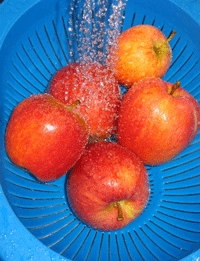The more you know, the more careful you are
With a daughter soon to complete a degree in health safety, discussions of Salmonella, E. coli and the like sometimes arise as we sit around the dinner table. As an agriculturally focused family, we like to think we’re pretty savvy about the best way to handle our produce to keep it safe and tasty.
Some are very concerned about food safety. A gentleman phoned the Postharvest Technology Center a few months ago, and shared that he was very concerned about eating strawberries. He thought perhaps he should scrub each one with a soft toothbrush, and then soak them in a diluted chlorine bath.
Others are much less aware of food safety concerns, sometimes using cutting boards and knives interchangeably between raw meat and produce items, or other unsafe food handling practices.
Dr. Roberta Cook, a marketing and postharvest specialist affiliated with the center reported, “in 2008, 53 percent of shoppers interviewed in a national survey by the Food Marketing Institute, named ‘bacteria or germs’ as a serious health risk to their food, ranking it as their number one concern.” The produce industry and the U.S. Food and Drug Administration continue to work hard to establish safe procedures for every step between the farm and the market.
Dr. Linda Harris, a food safety specialist, and Dr. Christine Bruhn, a consumer food marketing dpecialist, also affiliated with the Postharvest Technology Center, offer the following concise steps for the safe handling of produce:
- In the grocery cart and at home, keep fruits and vegetables separated from raw meat, poultry, and seafood to prevent cross-contamination.
- Once at home, store all fresh-cut ready-to-eat prepared produce in the refrigerator to keep it cold.
- Wash all whole fruits and vegetables, including larger items like melons, just before preparation for eating. Cut out damaged (bruised, discolored) areas before eating.
- Before and after handling fruits and vegetables, make sure that your work area and utensils are clean and that your hands have been washed with hot soapy water.
- Fruits and vegetables should be washed under running water. Soaking them in water increases the opportunity for cross-contamination and is not recommended.
- Produce such as apples, cucumbers and melons that can be rubbed without damage should be scrubbed using clean hands or a clean scrub brush.
- Dry washed fruits and vegetables with clean disposable paper towels.
- It is not necessary to wash ready-to-eat prewashed and packaged fresh-cut produce. If you choose to rewash this type of produce, follow the instructions above. Always wash unpackaged prepared salad mixes under running water prior to consumption.
- Once cut or prepared, all fruits and vegetables should be refrigerated promptly. After serving, refrigerate leftovers within 2 hours.
Additional produce safety resources:
"How to Properly Wash your Produce" video by Dr. Christine Bruhn.
For more University of California information about the safe handling of fruits and vegetables:
UC Home Gardening, Preservation and Storage Publications
Safe Handling of Fruits and Vegetables (pdf)
Food safety brochure (pdf)

